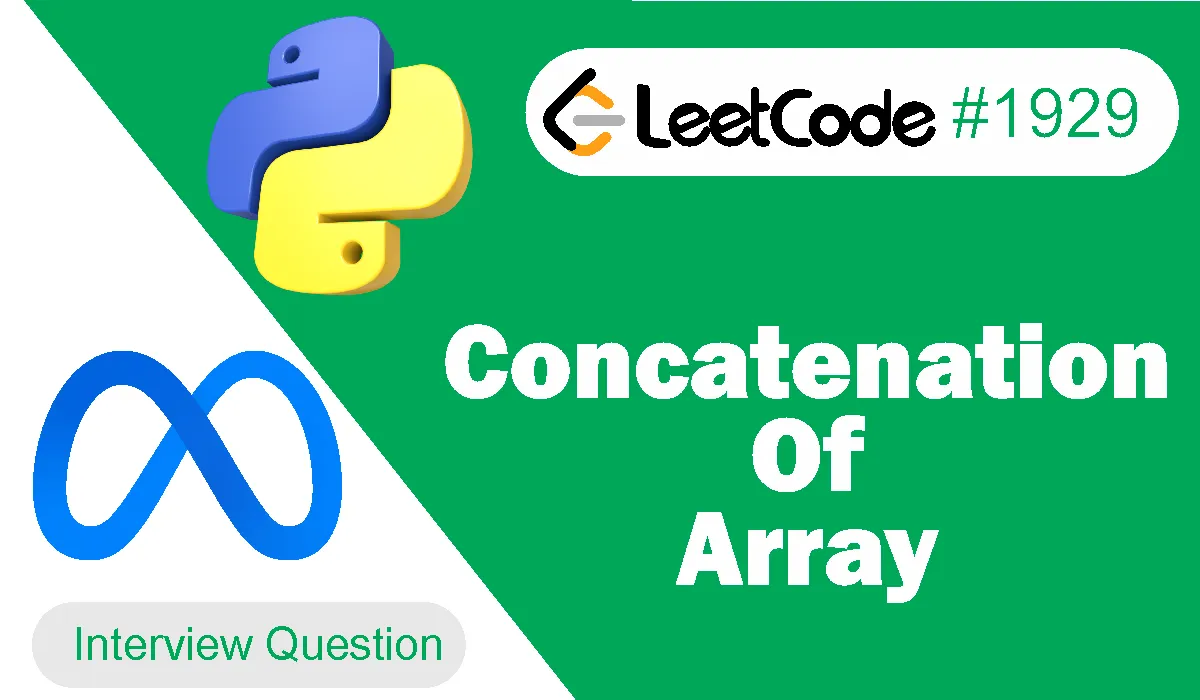Concatenation Of Array Leetcode Problem 1929 [Python Solution]
In this blog post, we will explore the LeetCode problem Concatenation Of Array (Problem 1929).
We will provide a detailed Python solution for this problem, along with explanations and a breakdown of time and space complexity.
If you're a beginner or someone looking to improve their coding skills, this guide is tailored for you.
Problem Overview
Problem Statement:
Given an integer array nums of length n, you want to create an array ans of length 2n where ans[i] == nums[i] and ans[i + n] == nums[i] for 0 <= i < n (0-indexed).
Specifically, ans is the concatenation of two nums arrays.
Your task is to return the array ans.
Example:
Let's understand this problem with an example.
Example 1:
Input: nums = [1,2,1]
Output: [1,2,1,1,2,1]
Explanation: The array ans is formed as follows:
– ans = [nums[0], nums[1], nums[2], nums[0], nums[1], nums[2]]
– ans = [1,2,1,1,2,1]
Constraints:
n == nums.length1 <= n <= 10001 <= nums[i] <= 1000
Now that we have a clear understanding of the problem, let's move on to the solution.
Efficient Python Code Solution
We will provide an efficient Python solution to this problem.
The idea is to create an empty array to store the result, then iterate through the input array (nums) and append each element to the result array.
To concatenate the array, we iterate through the input array twice, effectively creating two copies of it.
Let's write the Python code for this solution:
def getConcatenation(nums):
ans = [] # Initialize an empty array to store the result
for i in range(2): # Iterate twice to concatenate the array
for n in nums:
ans.append(n) # Append each element to the result
return ans
This code is straightforward.
It initializes an empty array ans to store the result.
It then iterates through the nums array twice and appends each element to ans.
Finally, it returns the concatenated array.
Let's move on to the time and space complexity analysis.
Time and Space Complexity
Time Complexity:
The time complexity of this solution is O(n), where n is the length of the nums array.
We iterate through the nums array twice, but the number of iterations is proportional to the size of the input.
Space Complexity:
The space complexity is also O(n).
We create an additional array ans to store the result, and its size is proportional to the size of the input array nums.
Reasoning Behind Our Approach
Our approach is quite simple and intuitive.
We create an empty array to store the concatenated result and then iterate through the input array, appending its elements to the result.
This solution is efficient and can be easily adapted to concatenate the array a different number of times, making it versatile for various scenarios.
In coding interviews, it's essential to come up with efficient and clean solutions.
The provided code accomplishes the task while maintaining readability and extensibility.
Related Interview Questions By Company:
Related Interview Questions By Category:
Conclusion
In this blog post, we addressed the LeetCode problem Concatenation Of Array (Problem 1929) and provided an efficient Python solution.
We explained the problem statement, gave a step-by-step breakdown of the solution, and analyzed the time and space complexity of our approach.
We hope this guide has been helpful to you in understanding this problem and its solution.
If you have any questions, suggestions, or would like to explore more coding problems, please feel free to comment and engage with the community.
Don't forget to engage for more coding content and stay tuned for our next coding challenge.
Thank you for reading, and happy coding!

